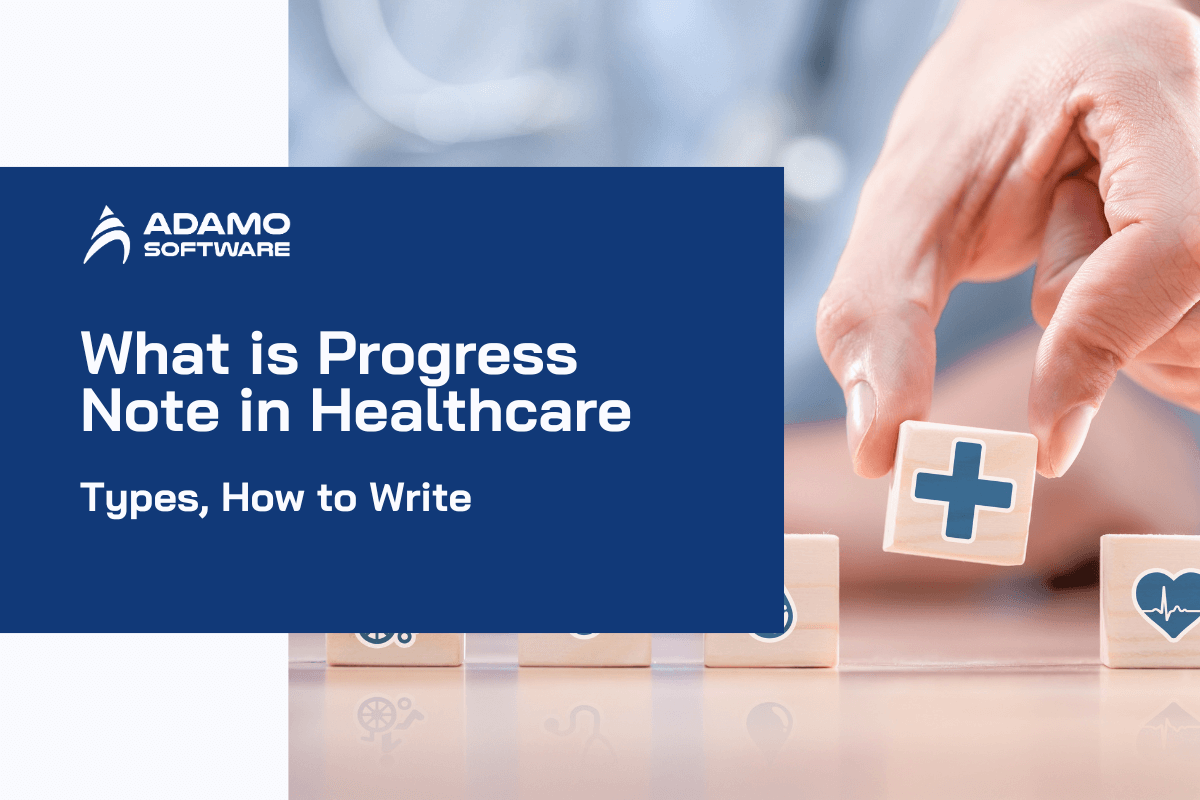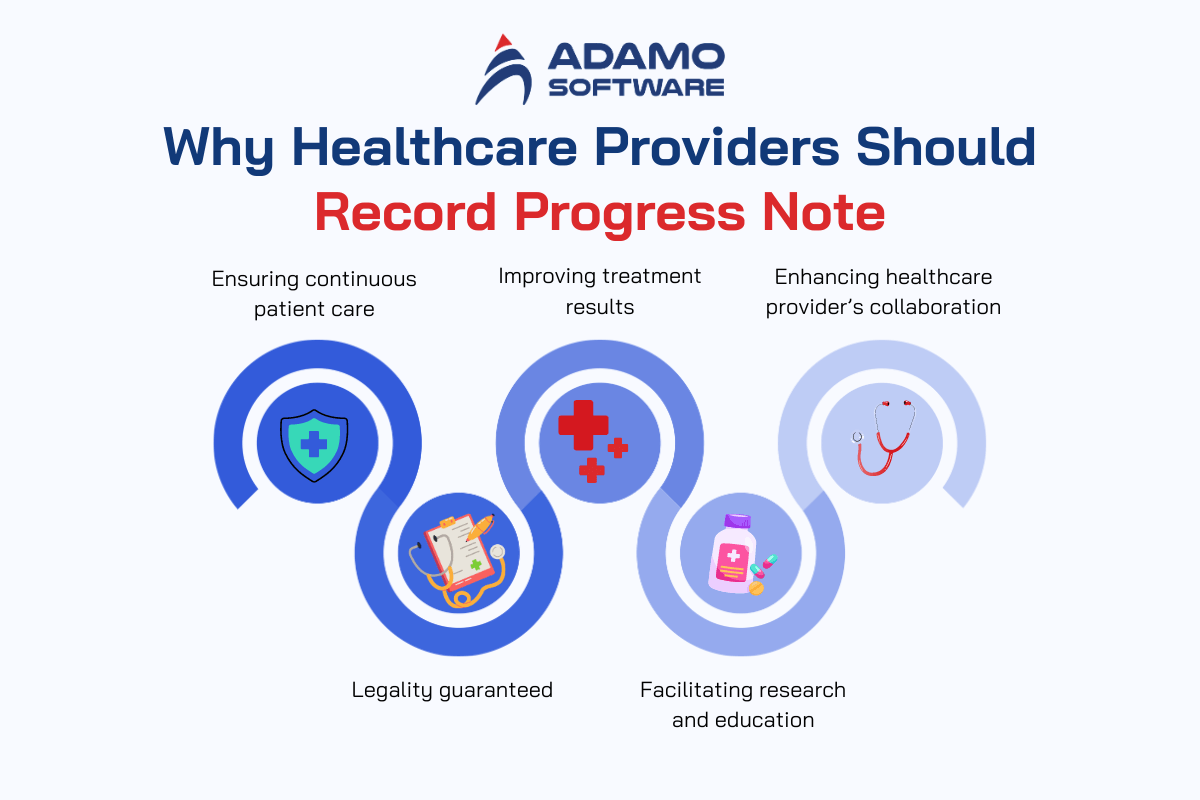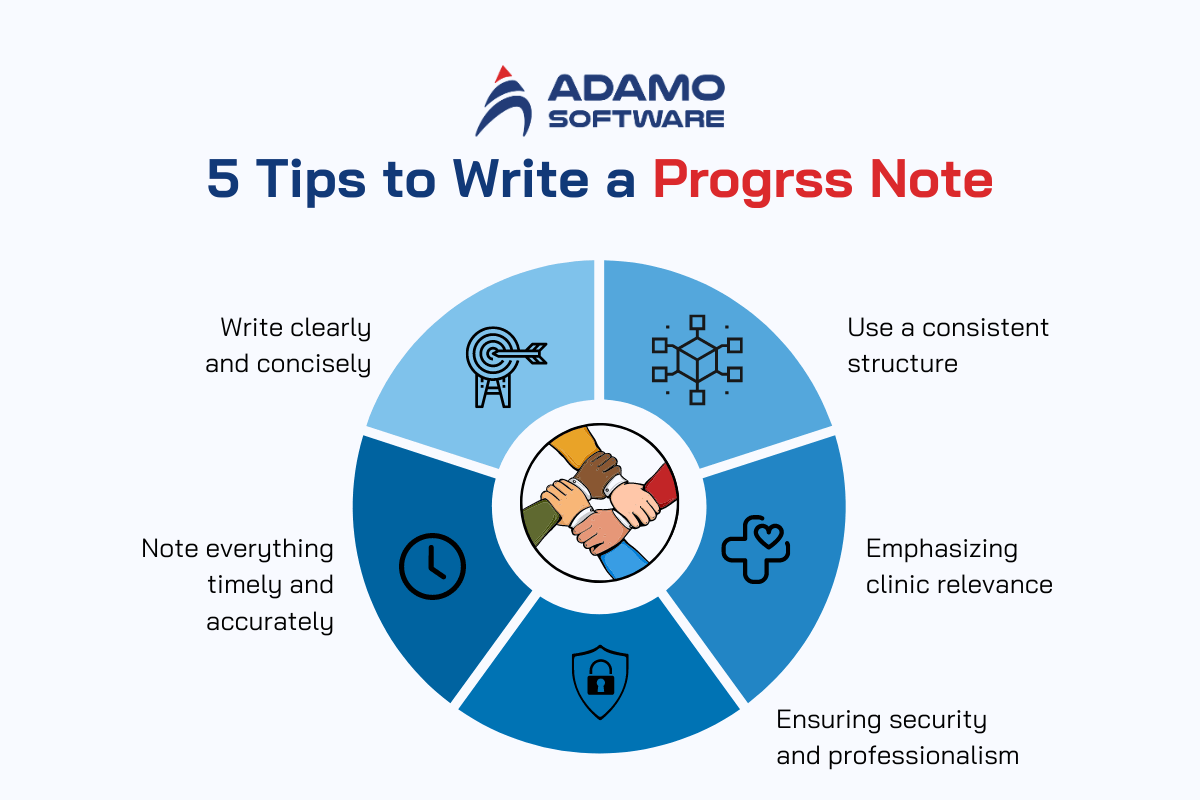What is a Progress Note in Healthcare – Types, How to Write

Currently, using progress notes is no longer strange to medical facilities. The progress notes track the patient’s health and their treatment process. Through the progress notes, medical providers can share information easily. Besides, they can assess treatment effectiveness, and provide better and continuous patient care
If you are a healthcare provider, you must thoroughly understand these notes. What is exactly a progress note in healthcare? Let’s find out more detailed information about this with Adamo Software.
This blog post will provide you with the importance and different types of progress notes in healthcare. In addition, you will also learn how to write progress notes in general and in healthcare. Finally, more detailed information on using healthcare software to simplify progress notes will also be included in this blog post. Refer to our blog post for well-researched, and up-to-date information.
I. What is a Progress Note in Healthcare – Understand the Basic
A progress note in healthcare is a type of record in a patient’s clinical document. Progress notes track treatment progress. These notes allow healthcare providers to know more about the patient’s health status. Besides, all symptoms and medical interventions the patient has received are also written. Progress notes are typically documented during appointments, hospitalizations, or treatment plan changes.
When many health professionals are involved in treatment, you will need a progress note in healthcare. This helps to ensure consistency in patient care. The note helps to record observations, assessments, and clinical decisions. These records can serve as a basis for further treatment actions. It is essential to record the progress notes accurately. This not only affects treatment effectiveness but also relates to medical staff professional responsibility.
You can explore more about Hospital Management Systems: Types, Key Features & Must-Know Insights here.
II. Why Healthcare Providers Should Record Progress Note
Medical providers need to use progress notes in the treatment of patients. Here are some featured reasons.

1. Ensuring continuous patient care
One of the most notable reasons to use a progress note in healthcare is the assurance of continuity of care for patients. Using the progress note, healthcare providers can keep track of patient’s medical data, thereby maintaining consistent monitoring and treatment for them, even when they are seen by different health professionals.
With proper progress notes, doctors can record information about the patient’s health status, previous interventions, and responses. This helps them quickly grasp the patient’s current status and keep a smooth and effective treatment for patients. In general, ensuring continuity of care not only improves the quality of treatment but also reduces the risk of missing or inconsistent information between visits.
2. Improving treatment results
A progress note in healthcare plays an important role in improving treatment results. By keeping detailed records of a patient’s symptoms, response, and progress after each treatment, healthcare providers can track the effectiveness of current treatments. This allows them to detect problems during treatment, thereby adjusting their treatment plans and prescriptions promptly.
In addition, progress notes also analyze detailed data on each patient’s treatment process, creating a valuable database for analysis and learning. By reviewing these notes, healthcare professionals can identify effective treatment patterns or discover factors that hinder the recovery process. The information collected in a progress note in healthcare serves as a basis for developing new, more optimal treatments in the future.
Thanks to the progress note, the quality of healthcare can be improved. Besides, the ability to make accurate clinical decisions can be enhanced.
3. Enhancing healthcare providers’ collaboration
Many medical experts can be involved in the treatment process of a patient. Therefore, a progress note in healthcare is needed to foster effective communication among healthcare providers. Thanks to the progress notes, they can access the patient’s condition, interventions performed, and their responses to treatment. This helps to avoid errors caused by the lack of information or misunderstandings.
4. Legality guaranteed
Legality guaranteed is also a reason to use a progress note in healthcare. The notes written by healthcare providers are legal pieces of evidence of clinical decisions, healthcare interventions, and patient treatment processes. They are useful when there is any conflict, complaint, dispute, or legal problem between medical providers and patients. These notes provide clear and detailed documents of all actions taken. This helps to protect the benefits of all stakeholders. Overall, maintaining accurate medical records means that healthcare facilities comply with legal regulations while ensuring that every aspect of care is documented and verifiable.
5. Facilitating research and education
A progress note in healthcare not only serves as a service report but also as a basis for research and education. Healthcare facilities and medical education can use progress notes to record treatment and patient responses which are rich data sources for analysis and lessons learned.
Progress notes can inform treatment effectiveness studies, health trend analysis, and new clinical guideline development. They can be used in medical education, providing real-life treatment examples and concrete illustrations. The note serves as a tool to train healthcare providers more effectively.
In general, using a progress note in healthcare brings many benefits to medical facilities. These benefits contribute to improving the quality of health care and developing the medical industry comprehensively.
III. Different Types of Progress Notes in Healthcare
There are many types of progress notes in healthcare. Each of them has its distinct structures and purposes to suit different specific clinical situations. SOAP, PIE, and DAP are three noticeable forms of progress notes.
1. SOAP
The SOAP note is the most popular type of progress note used to record patient information systematically and clearly. Let’s see what each part of a SOAP note represents.

- S
“S” stands for subjective. This part of the note focuses on the patient’s information about their condition. The patients will tell doctors some symptoms they are experiencing. For example, it can be a cough, fever, fatigue, etc. Besides, their medical history, lifestyle, and the environment affecting their health should also be noted. With these pieces of information, doctors will have an overall picture of the patient’s current health problems.
- O
Unlike the subjective information from the patients, the “O” (objective) part of a progress note in healthcare provides real-life data. These pieces of data are measured from the patient’s examination and testing. Doctors must focus on the data on blood pressure, heart rate, blood test results, and medical images like X-rays or MRIs, etc. The data helps doctors make more accurate decisions on patient treatment.
- A
The “A” in the SOAP note represents assessment. The subjective and objective data above will be synthesized and analyzed to conclude the patient’s condition. In this step, doctors will diagnose the condition, assess its severity, and identify any underlying issues. This evaluation enhances treatment decisions and ensures appropriate and timely interventions for patients.
- P
The “P” part of the SOAP note is the recommendation of the treatment plan for patients. The plan may include medication, tests, follow-ups, or lifestyle advice. This helps to ensure the effectiveness of medical decisions.
2. PIE
A progress note in healthcare can also include the PIE note. This type focuses on three main factors: problems, interventions, and evaluation. Using this type of note, healthcare providers will identify the patient’s current issues with their health or specific diagnoses.
In addition, the interventions or actions the healthcare professional took to address those problems are also recorded. These interventions may be prescribing medications, performing procedures, educating the patient, etc. After the record of problems and interventions, healthcare providers will record the evaluation of the effectiveness of those interventions. Overall, PIE notes help organize information in a systematic and easy-to-follow manner, ensuring that patient care is fully documented and can be adjusted on time.
3. DAP
DAP is a progress note in healthcare type with three main elements: Data, Assessment, and Plan. The data part in the note focuses on collecting subjective and objective patient information, health conditions, and treatment. In the assessment section of the progress notes, healthcare providers will make professional judgments, based on collected data, to determine a patient’s current health status or diagnosis. Finally, in the plan part, they will present a treatment plan or next steps to manage or improve the patient’s condition. Overall, DAP notes help ensure that patient care is systematically monitored and adjusted, supporting accurate and timely clinical decision-making.
IV. How to Write Progress Notes
A progress note supports the monitoring and evaluation of treatment, providing comprehensive care. But how to write a progress note effectively? Let Adamo Software answer this question. Below are some basic steps to write a progress note in healthcare.

1. Determining the note’s structure
Determining the note’s structure is the first and foremost step in writing a progress note. This improves information organization. When identifying the structure, you need to consider the purpose of your notes. In addition, it’s essential to know the type of information to record and how the record will be used.
With a clear structure, you and other healthcare experts involved in the patient’s treatment can easily follow and understand the patient’s condition. Besides SOAP, PIE, and DAP structures mentioned above, you can also choose the narrative structure which is suitable when you need to record the entire treatment process and patient developments over time.
2. Collecting data
After identifying the note structure, you will collect the data, which ensures all aspects related to the patient’s health condition are accurately and comprehensively recorded. The data collected must be both subjective and objective. When gathering information, you should not focus on all details. These details will be the basis for the doctor to make an accurate diagnosis and plan effective treatment. Thanks to the accurate reflection of the patient’s actual condition, you can provide your patients with the most effective care and treatment process.
3. Assessing the patient’s condition
Assessing the patient’s condition is an indispensable part of creating a progress note in healthcare. In this step, healthcare providers will synthesize and analyze the collected data to assess the patient’s health status. The assessment includes a list of systems and careful consideration of the relationships between different factors and their impact on the patient’s overall condition. An accurate and comprehensive evaluation will guide the subsequent treatment plan, ensuring that medical interventions are performed in the right direction and promptly, contributing to improved patient care.
4. Planning
Planning is the last step in writing a progress note in healthcare. In this step, medical professors will build a detailed roadmap for managing and treating the patient’s health condition. The plan for the progress notes can include many elements, from prescribing medications, and ordering additional tests, to recommending changes in diet, exercise, or other self-care measures. Effective planning ensures that all medical interventions are performed at the right time and in the right way while creating a clear roadmap for the patient and healthcare professionals to monitor and evaluate progress.
By following the four steps above, you can write efficient progress notes, helping to improve the quality of patient care and supporting clinical decision-making.
V. 5 Tips to Write a Progress Note in Healthcare
Writing a progress note in healthcare is essential to record the patient’s treatment process and health condition. To ensure that your progress notes accurately reflect the patient’s health condition, you may want to follow these five tips below.

1. Write clearly and concisely
When you write a progress note in healthcare, you should write it clearly and concisely. This helps to ensure that information is effectively communicated among medical experts and other stakeholders. The readers can grasp important information without taking too much time. This is especially important in making quick and accurate clinical decisions.
2. Use a consistent structure
There are many types of progress notes; however, you should only use one so that the information is organized and easy to follow. By following a fixed structure, healthcare providers can note all important aspects of the patient’s treatment and support their colleagues in grasping and understanding the patient’s condition. When all notes follow the same format, reviewing and evaluating progress notes becomes faster and more efficient, minimizing the risk of missing important information.
3. Note everything timely and accurately
Healthcare providers need to note everything timely and accurately for a progress note in healthcare. Immediate documentation of examination or procedure outcomes helps you avoid missing important details and maintain a high level of accuracy in information. When you take note, ensure that the time, date, and changes in the patient’s condition are fully recorded. This helps to create an accurate record that supports clinical decision-making and more effective treatment.
4. Emphasizing clinical relevance
Emphasizing clinical relevance makes the information recorded truly valuable in supporting treatment. When writing a progress note in healthcare, you should only include relevant information on the patient’s condition and treatment. For example, you can note the symptoms, test results, response to medication, and necessary adjustments to the care plan. By focusing on the clinically important elements, your note will be useful for monitoring and healthcare decision-making.
5. Ensuring security and professionalism
Ensuring security and professionalism is an essential principle when writing a progress note in healthcare. You must strictly follow patient confidentiality regulations, such as HIPAA, to ensure that all personal details are protected and not disclosed. Additionally, you should use professional language and avoid inappropriate comments. This not only protects the patient’s rights but also strengthens the writer’s reputation and responsibility in the medical environment.
By following the five tips above, you can record information clearly and ensure confidentiality and professionalism at work. Accurate progress notes in healthcare will become an important tool supporting the treatment process and helping healthcare providers make better clinical decisions.
VI. Using Healthcare Software To Simplify Progress Notes
A progress note in healthcare can be simplified with the support of healthcare software. The electronic health record system (EHR) is software designed to assist healthcare professionals in recording and managing patient information more easily and accurately.

Every individual can have a comprehensive digital health record, containing important information such as demographics, medical history, and test results. Also, progress notes about medical histories and diagnoses are stored in the EHR. The linkage between EHR and the progress notes ensures that up-to-date information about patient status is always available. This helps to improve continuity of care and make faster, more accurate clinical decisions.
The integration with other tools and systems within the hospital is also a big advantage of healthcare software. Information from medical devices, lab tests, and medical imaging can be directly linked to progress notes, creating a comprehensive picture of a patient’s condition without switching between multiple systems.
By using healthcare software, healthcare providers can enhance the security of the progress notes. The software is designed to meet strict health information security requirements, such as HIPAA standards, which help protect patient privacy.
In summary, using healthcare software can simplify the documentation process and enhance the overall efficiency and quality of patient care. This improves the quality of patient care by increasing the accuracy, efficiency, and security of medical information recording and management.
VII. How is Adamo’s Healthcare Software Solutions Revolutionizing Progress Notes
If you are looking for a unit to help you integrate your progress notes with healthcare software development, Adamo Software can be your trusted partner. As one of Vietnam’s leading app development companies with experienced and professional experts, we are confident to meet your requirements and expectations.
Adamo’s health software solution is revolutionizing the healthcare progress note by providing advanced technology tools to optimize patient information recording and management processes. Our software integrates automation features such as auto-fill, speech-to-text, and real-time access to information, helping you save time and reduce errors. Besides, we also focus on enhancing security and legal compliance, ensuring that all progress notes are securely stored, and creating a modern, efficient, and trustworthy healthcare environment.











